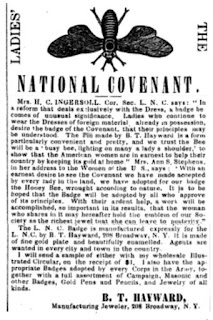But before we get to the bee, let's look at the national crisis. From the History of Woman Suffrage, we read:
"After the war was fairly inaugurated, the manufactories of the country largely turned their attention to the production of material required by the army, which, combined with the immense number of volunteers from such avocations, and the rise in prices of all home manufactures, created an immense import of foreign goods, which, pouring into our country when gold was at the highest, brought to our doors a danger no less formidable than that of the Rebellion. It was shown from official returns, in 1863, that during a period of nine months, the imports, at the port of New York alone, amounted to $160,000,000 in gold; equal, including exchange, freight, insurance, etc., to twice that sum, while or exports amounted to only $120,000,000 in paper."
In other words, "American-made" became so expensive during the war that ladies were purchasing imported clothing, jewelry and accessories. This had created a disastrous trade deficit, threatening a United States recession.
The Ladies' Answer
Therefore, in 1864, a "Ladies National Covenant" was formed, their pledge being this:
"For three years, or during the war, we pledge ourselves and the country, to purchase no imported goods where those of American manufacture can be obtained, such as "dress goods of velvet, silks, grenadines, India crape and imported organdies, India lace and broche shawls, fine wrought laces and embroideries, watches and precious stones, hair ornaments, fans, artificial flowers and feathers, carpets, furniture, silks and velvets, painted china, ormolu, bronze, marble, ornaments, and mirrors."
Pictured are some of the imported items banned by the Covenant's Pledge, besides fabric.
Of course, some ladies already had imported clothing so in order to make sure that everyone knew of their patriotism, the Ladies National Covenant Corresponding Secretary observed that "Ladies who continue to wear the dresses of Foreign material, already in possession, desire the Badge of the Covenant, that their principles may be understood." Indeed, you wouldn't want your dress to make you look unpatriotic!
The Ladies' Badge
Therefore, a national badge was adopted for those who had taken the Pledge. "The emblem of this Covenant was a black or gilt bee, worn as a pin fastening the national colors, upon the hair, arm or bosom, as a public recognition of membership."
Want to wear your lovely 1863 imported silk dress? Not to worry, just wear a Bee Cockade with it and no one will doubt your patriotic principles!
A popular Broadway jeweler (his ad is pictured here) was given the job of creating these bees and his advertisement not only touted the bees, but other badges for cockades as well.
"The L.N.C. Badge is manufactured expressly for the L.N.C., by B.T. Hayward, 208 Broadway, New York. It is made of fine gold plate and beautifully enameled. Agents are wanted in every city and town in the Union.
"I will send a sample together with my wholesale Illustrated Circular on the receipt of $1. I also have the appropriate Badges adopted by every Corps in the Army, together with a full assortment of Campaign, Masonic, and Society Badges, Gold Pens and Pencils and Jewelry of all kinds."
My Bee Badges
For those who want to portray the 1860s "Buy American" campaign - or those who want a badge for a modern "Buy American" campaign - I offer a repro of this cockade! My bee looks very similar to the original and it's fastened with the appropriate "national colors" of red, white and blue.
Many thanks to Anna Worden Bauersmith for her wonderful research that got me interested in this topic.






No comments:
Post a Comment